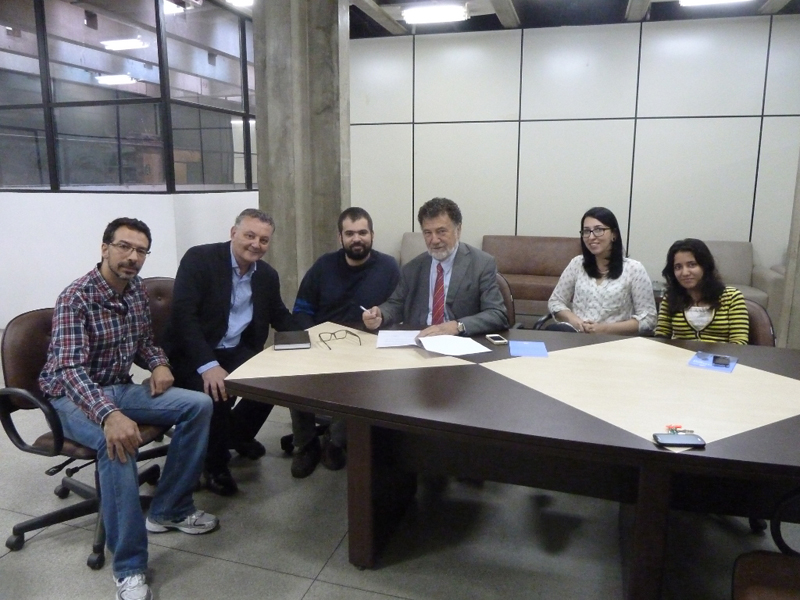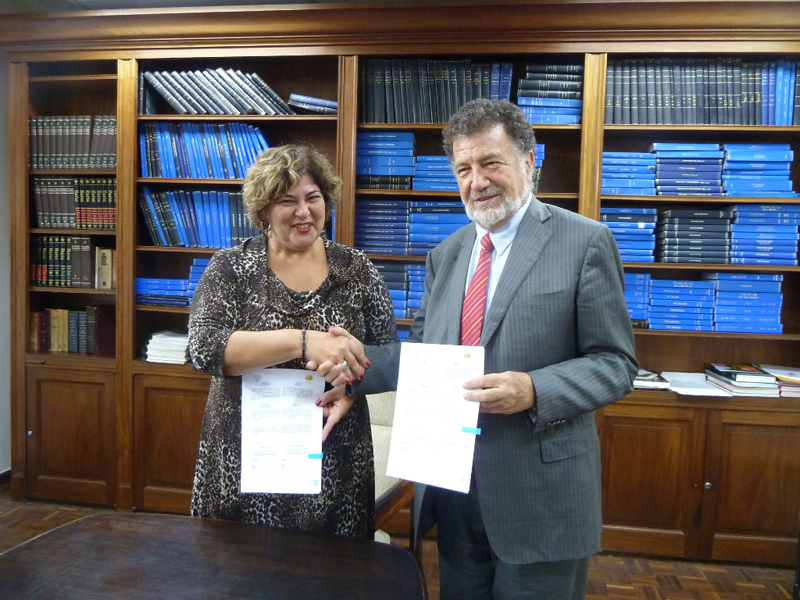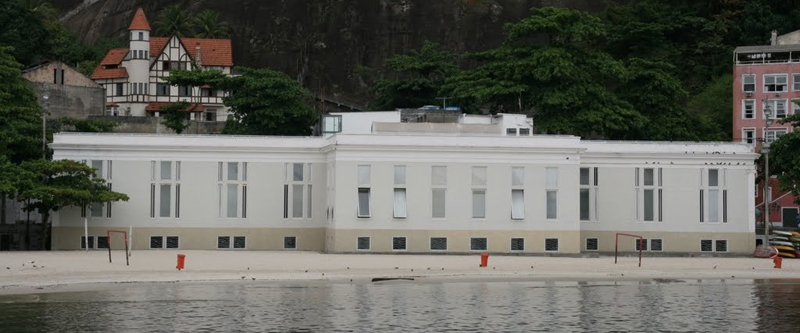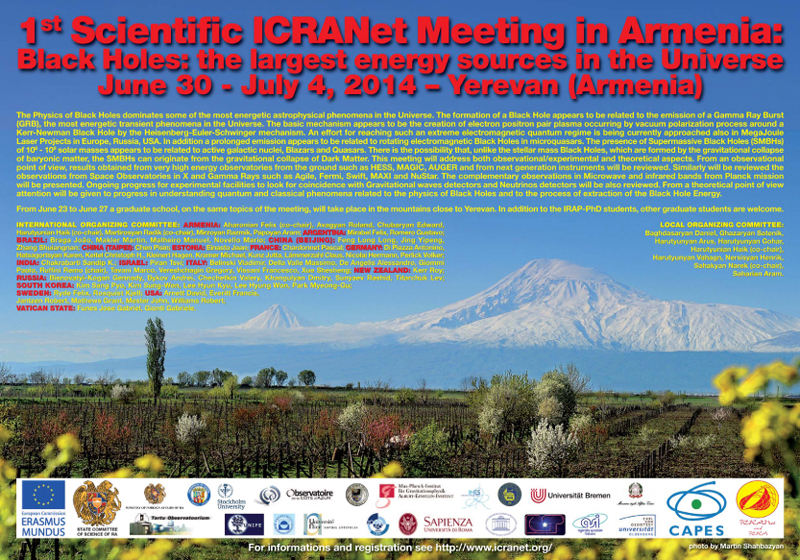

| Newsletter Chinese May/June |

|

|





ICRANet 简报
2014 年 5,6 月
超新星、伽玛暴和诱导引力坍缩研讨会
(Les Houches, 法国)
由国际相对论天体物理中心(ICRANet)、国际相对论天体物理博士项目和欧盟 Erasmus Mundus 博士项目及 CAPES-ICRANet 联合项目所共同支持,Pascal Chardonnet、Georges Meynet 和 Remo Ruffini 共同组织研讨会于 2014 年 5 月 11-16 日在法国来苏什举行。这次研讨会展示了很多天体物理研究中的重要结果,这些结果对于超高能(1052–1054 尔格) 长伽玛暴和超新星成协现象的前身系统及其物理机制和其后所隐含的宇宙学意义具有重要价 值。伽玛暴是伽马射线闪耀,在全天空中几乎每天都会出现。在整个宇宙中,它们是最高能 量的事件,其几秒内所爆发的伽玛射线总能量等效于同样时间内其它所有天体加在一起在全 部电磁波谱段(从射电到伽玛波段)所辐射的能量总和。伽玛暴是在黑洞的形成过程中发射 出来。长暴被定义为时间长于 2 秒的爆发,短暴则是短于 2 秒的。有一些长伽玛暴表现出跟 超新星相关(成协),这样的暴发对应着大质量恒星演化的最后阶段。这种在伽玛暴和超新 星之间的成协性对应着伽玛暴总辐射能量大于 1052 尔格(比我们星系中所有恒星在一秒中所 有能量辐射的 2 亿倍还大)。成协性现象可以在诱导引力坍缩图像中得到解释,这种图像由 Ruffini 教授及合作者在 2001 年首次提出并在 2006 年的柏林 Marcel Grossmann 大会上得到进 一步的修正。这些伽玛暴-超新星源的前身体被假设成一个紧密的双星系统:一个接近超新 星爆发边缘的大质量恒星核(主要由铁、碳和氧构成,故为“FeCO”)和另一个伴随的中子 星。这样特别的系统被命名为 binary driven hypernovae (BdHNe)
本次会议的重要参加者是专程来自于洛斯阿拉莫斯国家实验室的教授 Christopher L. Fryer,此外还有 Mackenzie Warren 来自于 Notre Dame in South Bend 大学(美国印第安那)。他们介绍了超新星爆炸数值程序在上述诱导引力坍缩图像下的应用和重要进展。由洛斯阿拉 莫斯实验室的 Chris Fryer、David Arnett 和利物浦的 Jim Wilson 经过多年得出的这个程序,后 者的工作被 Notre Dame 大学的 Grant Mathews 及其组所拓展。此次会议由于 5 月 12 日雨燕 和费米卫星观测到的新伽玛暴 GRB 140512A 而变得更有意义。ICRANet 全体成员组展示了 它们对于伽玛暴研究的模型。与此同时,Giovanni B. Pisani 和 Ana Virginia Penacchioni 从第一性原理出发能够预言在红移 0.6 到 1.1 之间的天体事件。这个预言在随后即在 5 月 19 日被加那利群岛的 NOT 望远镜观测结果所证实(红移 0.725)。上图中这个预言被展示在黑板 上。此次探讨会由于丰富的报告而显得更加多彩,这些报告多来自于在 ICRANet 教授们(C.L. Bianco, L.Izzo, J. Rueda, S.-S. Xue)所指导的学生们和合作科学家那不勒斯天文台台长 Massimo Della Valle 教授及莫斯科的 Aleksei Aksenov。特别的,如用伽玛暴做距离指示来探测高红移的 恒星分布,L. Izzo 展示了 BdHNe 前身星系统在非常高红移(z=8.2,近似在宇宙大爆炸的 6.5 亿年后)的可能性及其在宇宙学上的重要应用。其它重要结果由 IRAP 博士生 Marco Muccino 和王瑜报告给出展示。[Ruffini et al. A&A (2014);参见下文]对于 BdHNe 前身星系统原型 案例 GRB 090618 的分析。 有证据表明 BdHNe 的 X 射线光度起源于超新星的宽角喷流,而 不是来自于伽玛暴。这个方面体现在所有 BdHNe 的 X 射线光度都存在一个嵌套结构和普适 的晚期幂率行为[Pisani et al. A&A (2013)]。这体现了在光学、伽玛和高能发射都保持了同样的 标度率[Ruffini et al., ApJ submitted (2014)]。 
Highlights on an ICRANet publication of this month: On binary driven hypernovae and their nested late X-ray emission
In the paper by Rueda and Ruffini, Astrophysical Journal Letters (2012), 758, L7 it has been described the rapid evolutionary sequence of these systems, which consists of four distinct emission episodes, observed in the prototypical source GRB 090618 and described in the paper by Izzo, Rueda and Ruffini, Astronomy & Astrophysics Letter (2012). A brief summary of this time sequence is outlined: Episode 1 corresponds to the FeCO core explosion as a SN, with the consequent birth of a new NS (named ν-NS) as the remnant; part of the SN ejecta triggers an accretion process onto the NS companion, and a prolonged interaction between the ν-NS and the NS binary companion occurs. Episode 2 corresponds to the actual GRB; it occurs when the companion NS reaches its critical mass and gravitationally collapse to a black hole. Episode 3, observed in the X-rays, corresponds to an emission with a very precise behavior in time, consisting of a steep decay, starting at the end point of Episode 2, and then a shallow decay phase (or a plateau), followed by a late common power-law decay. Episode 4 corresponds to the optical SN emission occurring after ~10–15 days in the source cosmological rest frame.
In the paper by G.B. Pisani, L. Izzo, R. Ruffini, C.L. Bianco, M. Muccino, A.V. Penacchioni, J.A. Rueda, and Y. Wang, Astronomy & Astrophysics Letter (2013), 552, L5, it has been pointed out the most striking feature of these BdHNe: the common behavior in their late Episode 3 emission. No matter what is the total energetics of the whole event, the duration of Episode 1 and 2, or the distance from the observer of these systems, when we compute the amount of energy emitted per unit of time (luminosity) in a common energy band, the late Episode 3 emission at times larger than 104 s follows the same behavior in time and luminosity, providing a perfect overlap. This feature, in principle, would make these sources a possible distance indicator and suggests that the underlying physical mechanism must be the same in all of them. In the recently published work by R. Ruffini, M. Muccino, C. L. Bianco, M. Enderli, L. Izzo, M. Kovacevic, A.V. Penacchioni, G.B. Pisani, J.A. Rueda, Y. Wang, 2014, Astronomy & Astrophysics, 565, L10, which is the subject of these highlights, we report the first attempt to give a global physical insight on the origin of Episode 3. One of the results of this work concerns the size of the emitting region where the Episode 3 originates, inferred from the analysis of the prototypical BdHNe, GRB 090618. During the steep decay phase of its Episode 3, a thermal component has been observed in the X-rays. Beyond its very physical meaning, a thermal spectrum is the only emission model which can provide a direct estimate of the size of the emitting region. In the present case it has been inferred the initial size of the source of ~1013 cm, which expands at 0.9 times the speed of light c. This represents the evidence that Episode 3 X-ray luminosity of these sources originates from the wide angle emission of the SN ejecta, rather than from the GRB as it was purported before, since the GRB has typically much higher expansion velocities and, therefore, larger typical dimensions of the emitting region of ~1016-1017 cm (see figure above). The steep decay, the plateau, and the late power-law decay in Episode 3 luminosities for three selected BdHNe (GRB 060729, GRB 061121, and GRB 130427A) were compared and contrasted. Not only these selected BdHNe present a late time overlapping, but they evidence further properties: the higher the energetic of the source, the shorter the plateau phase duration, while the late time emission always overlaps following a precise power-law decay. This represents an authentic nested structure (see figure below). In particular, with the inclusion of all our best known sample of BdHNe, precise scaling laws involving the plateau duration and luminosity, as well as the average luminosity of prompt emission have been inferred. The common asymptotic late power-law behavior in all BdHNe can be explained by the role of r-process, which are responsible of creating heavy elements. The best scenario for the r-process occurs during the merger of binary NSs (i.e., during the interaction of the companion NS with the ν-NS), where a very neutron-rich dense medium favors the production of nuclei heavier than iron. These are unstable and then decay in lighter daughter nuclides, generating a cascade of reactions, which represents the “fuel” that keeps the late Episode 3 emission going on. Recent computations of the luminosity obtained by the r-process provide a power-law with slopes -1.4≤α≤-1.1 [see the paper by B. D. Metzger, G. Martınez-Pinedo, S. Darbha, E. Quataert, A. Arcones, D. Kasen, R. Thomas, P. Nugent, I. V. Panov and N.T. Zinner, (2010) Monthly Notices of the Royal Astronomical Society, 406, 2650], strikingly similar to the ones we have found in the late Episode 3 X-ray luminosity.
ICRANet 在巴西和拉美的活动
在五月的最后一周,ICRANet 主任 Ruffini 教授访问了巴西并参加了很多相关仪式以及 南美国家的活动。Ruffini 教授在里约热内卢的巴西物理中心召开了一个特别的科学组委会和 IRAP 博士委员会会议并参与了两个重要的庆祝会。第一个庆祝会是在坐席 Niteroi, RJ 签署 ICRANet 和 UFF 协议。第二个庆祝会是和 UERJ 续签五年协议,这个协议首次开始于 2009 年。
这些协议跟此前已经和 CAPES、CBPF 及 FAPERJ,还有 Ceara 政府、ITA、 UFPB、UFRGS、 UNIFEI 及 INPE 签署的一样,为来自欧洲和南美洲科学家和研究者提供了国际科 学研究合作的机遇。 此外,Ruffini 教授会见了里约热内卢技术中心秘书 Franklin Dias Coelho 并在历史上著 名城市 Cassino UCRA 参加了欧洲设计研究所(IED)总部的创建仪式,突出了两大研究所 ICRANet 和 IED 的主题“从人类的设计到宇宙的设计”。 值得注意的是在 2014 年,引力研究基金会授予 C. R. Argüelles 和 Ruffini 教授荣誉奖, 基于它们解释了星系中的超大质量黑洞和暗物质晕。 (http://arxiv.org/abs/1405.7505). 2014 年 7 月 9 日,根据 ICRANet 和 UNAM(Universidad Nacional Autonoma de Mexico)条 约 , 墨 西 哥 UAM ( Universidad Autónoma Metropolitana ) 校 长 Salvador Vega y León 博 士 和 ICRANet 主 任 Ruffini 教 授 在 墨 西 哥 城 签 署 了 ICRANet 和 UAM 间 的 协 议 。(http://www.icranet.org/docs/UNAMsigned.pdf).
2014 年六月/七月第一届 ICRANet 亚美尼亚-埃里温科学会议
黑洞物理主导了宇宙中一些最高能的天体物理现象。黑洞的形成涉及伽玛暴的发射, 伽玛暴是宇宙中能量最高的瞬时现象。这些现象的基本原理是电子-正电子对等离子体的产 生同时伴随了在科尔-纽曼黑洞周围由于海森堡-欧拉-施温格机制的真空极化过程。期望达到 这种极强电磁场的 MegaJoule 激光项目正在欧洲、俄罗斯和美国进行。此外,加长发射与微 类星体中的旋转电磁黑洞有关。达到 10^8 和 10^9 倍太阳质量的超大质量黑洞的存在体现 了与活动星系核,Blazars 天体和类星体存在关系。不像由于重子物质的引力坍缩所形成恒星 质量的黑洞,超大质量黑洞可能起源于暗物质的引力坍缩。此次会议讨论了包括观测、实验 和理论各方面。从观测上,人们总结了来自地面观测设备 HESS、MAGIC、AUGER 和下一代设备所能得到的超高能观测结果。会议还讨论了从 X 和伽玛波段空间天文台如 Agile、Fermi、 Swift、MAXI 和 NuStar 获得的观测结果。也讨论了从普朗克任务得到的微波和红外 观测结果。会议还介绍了引力波探测器及中微子探测器一些进展。理论上,还讨论了理解黑 洞的经典和量子现象以及提取黑洞能量的过程。
在此会议之前从 6 月 28 日到 29 日,我们在 Aghveran 组织了 IRAP 博士生学校。 会议日程请参见 e: http://www.icranet.org/images/stories/Meetings/meetingArmenia2014/preliminary_program.pdf 请下载海报: http://www.icranet.org/images/stories/Meetings/meetingArmenia2014/Poster_Armenia_Yerevan_2014.pdf |
|
||








